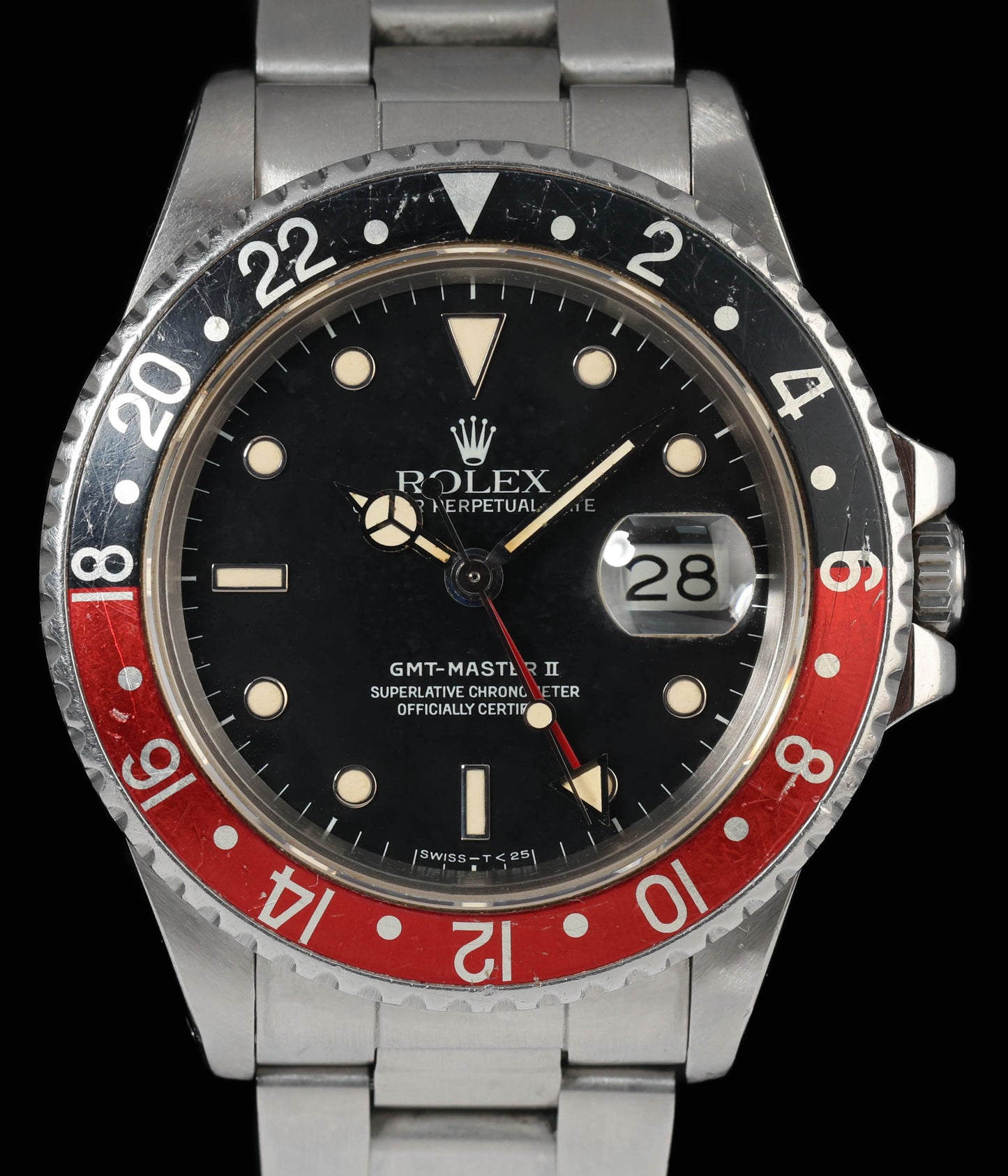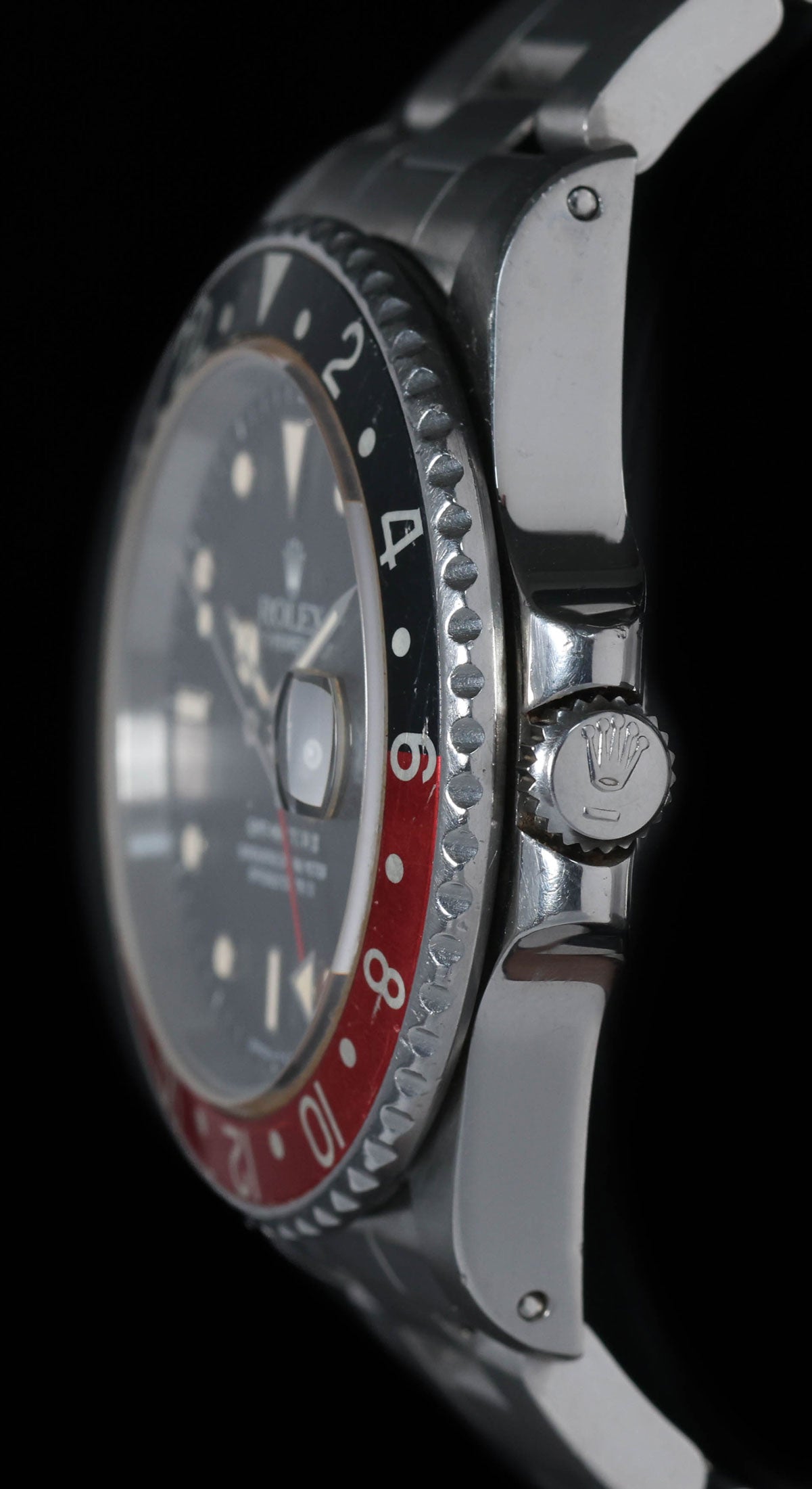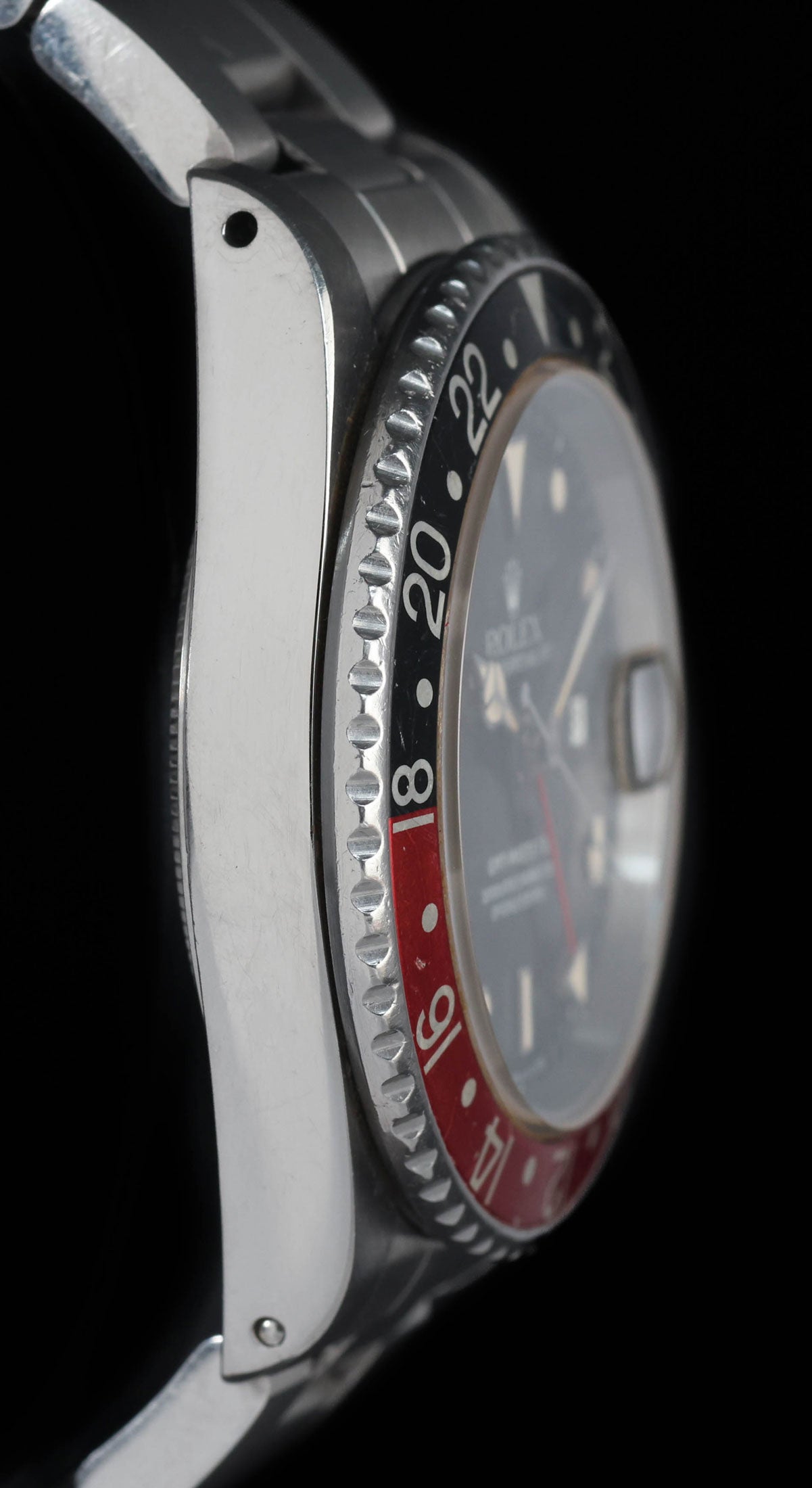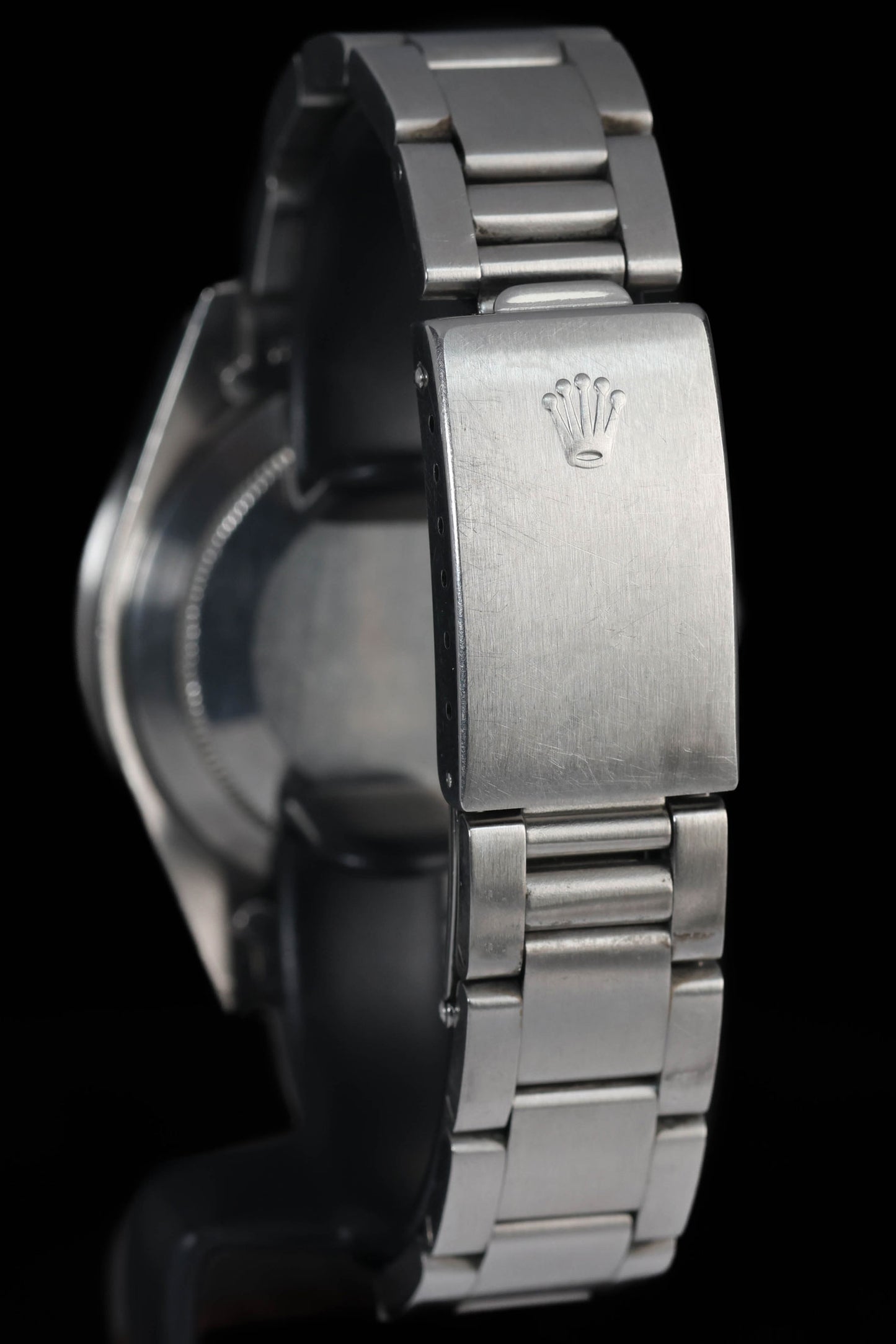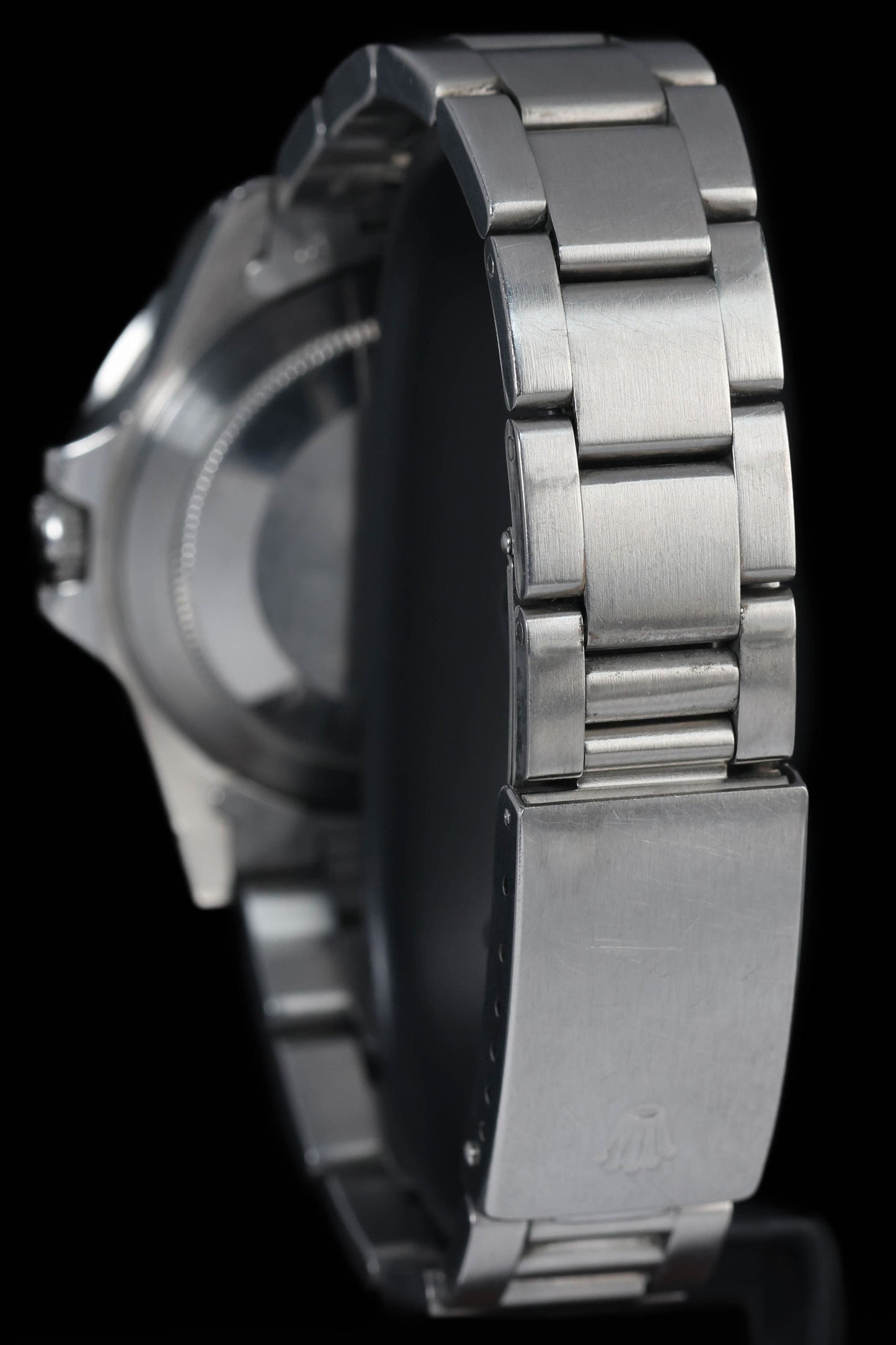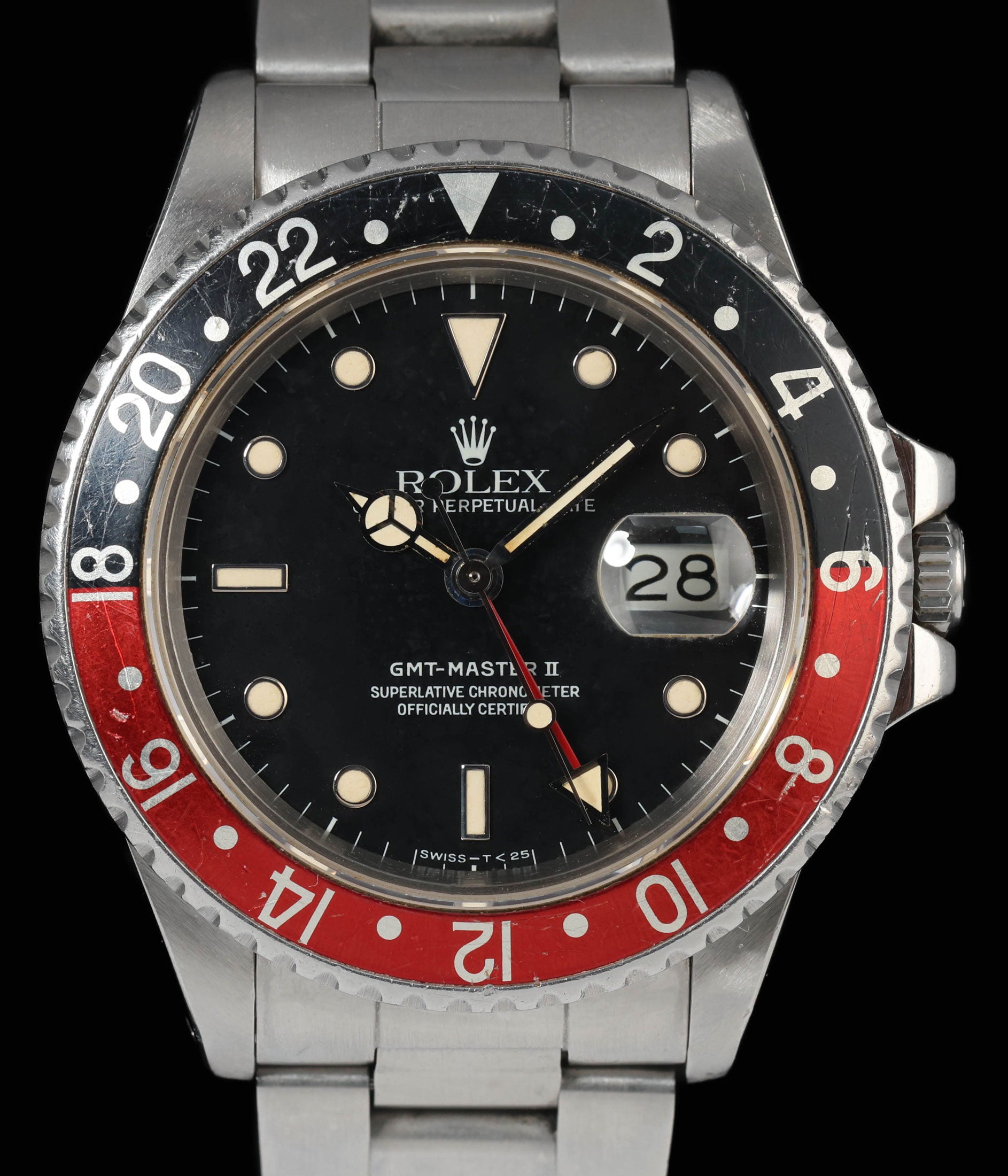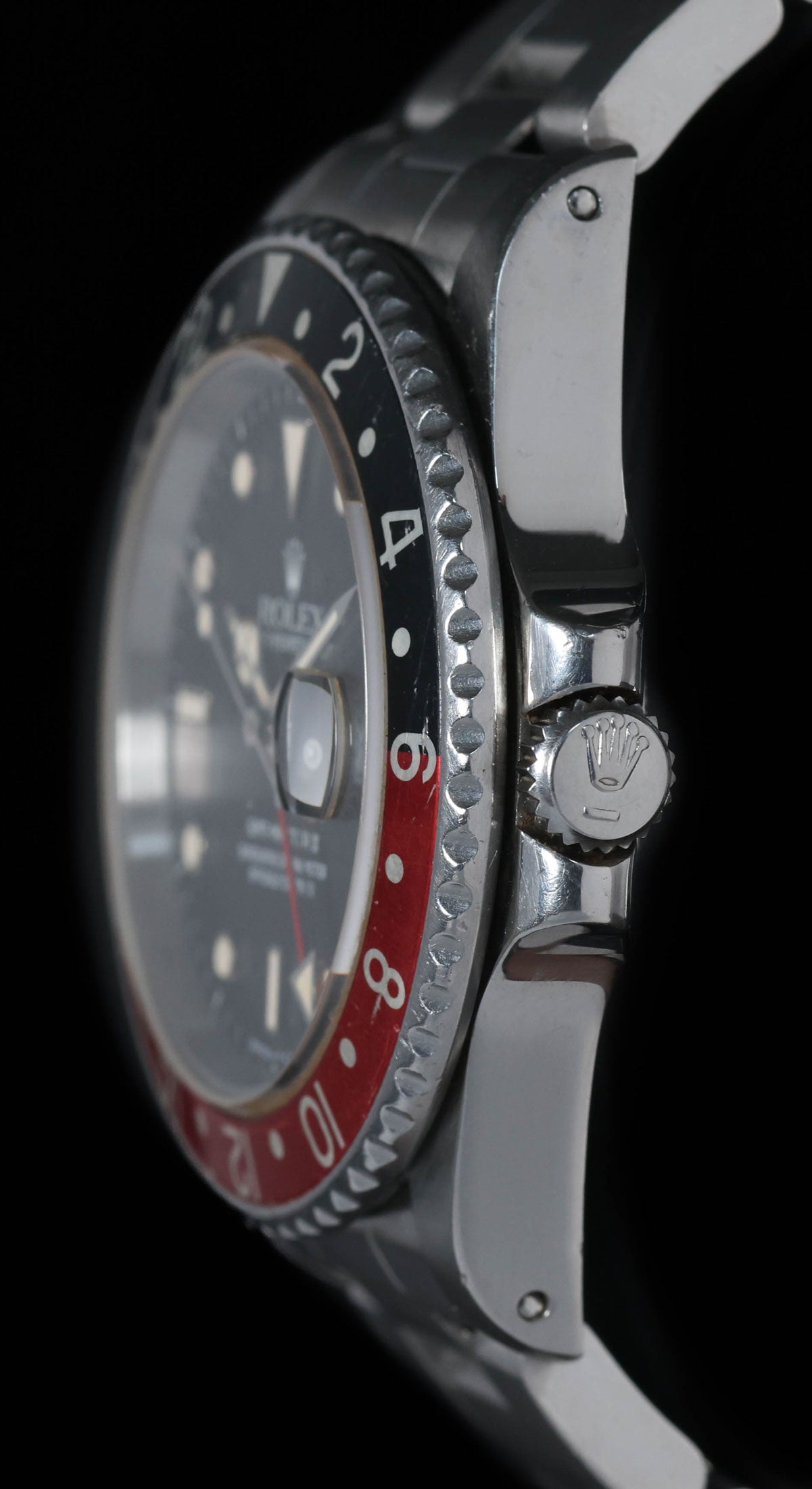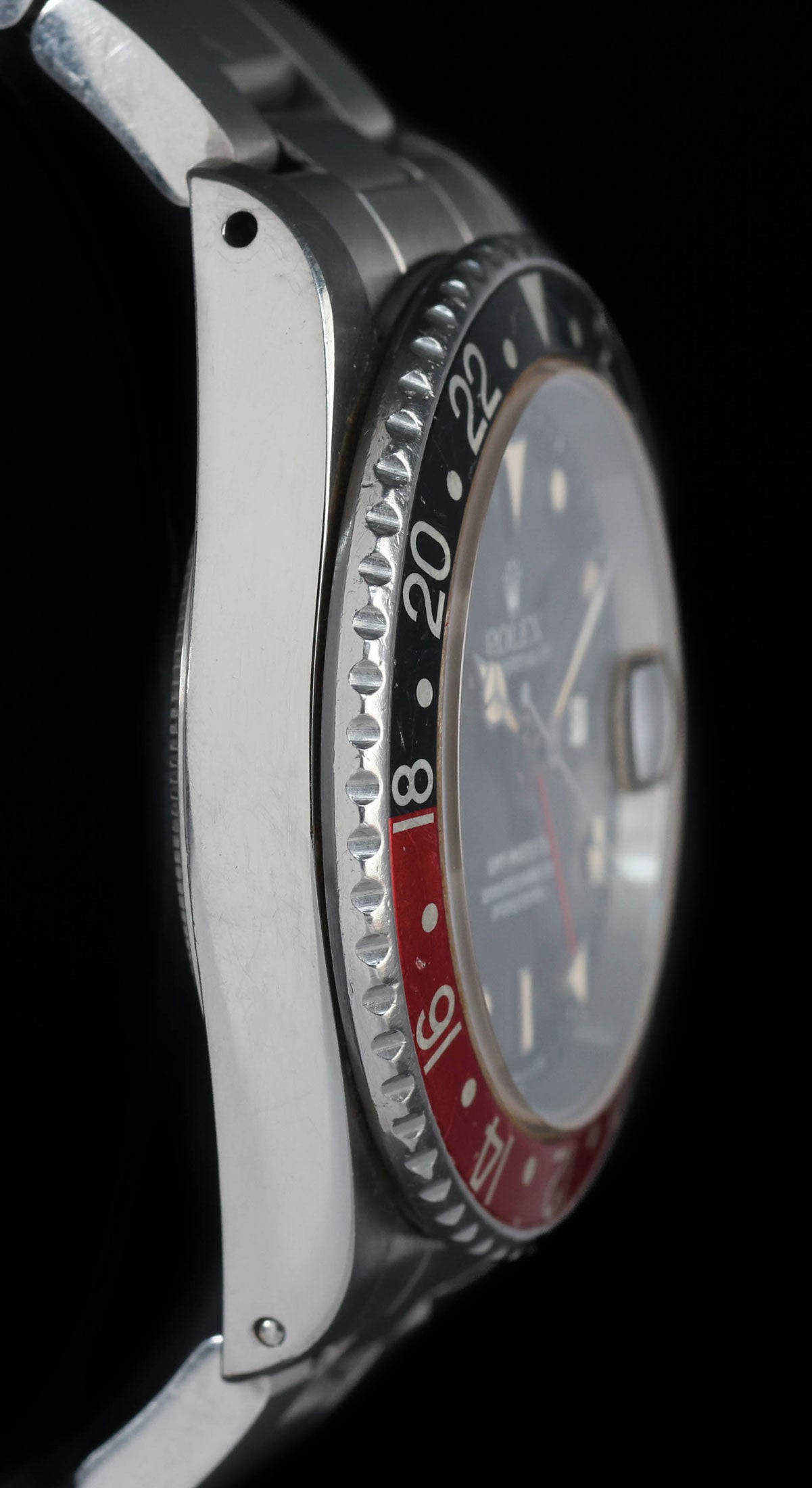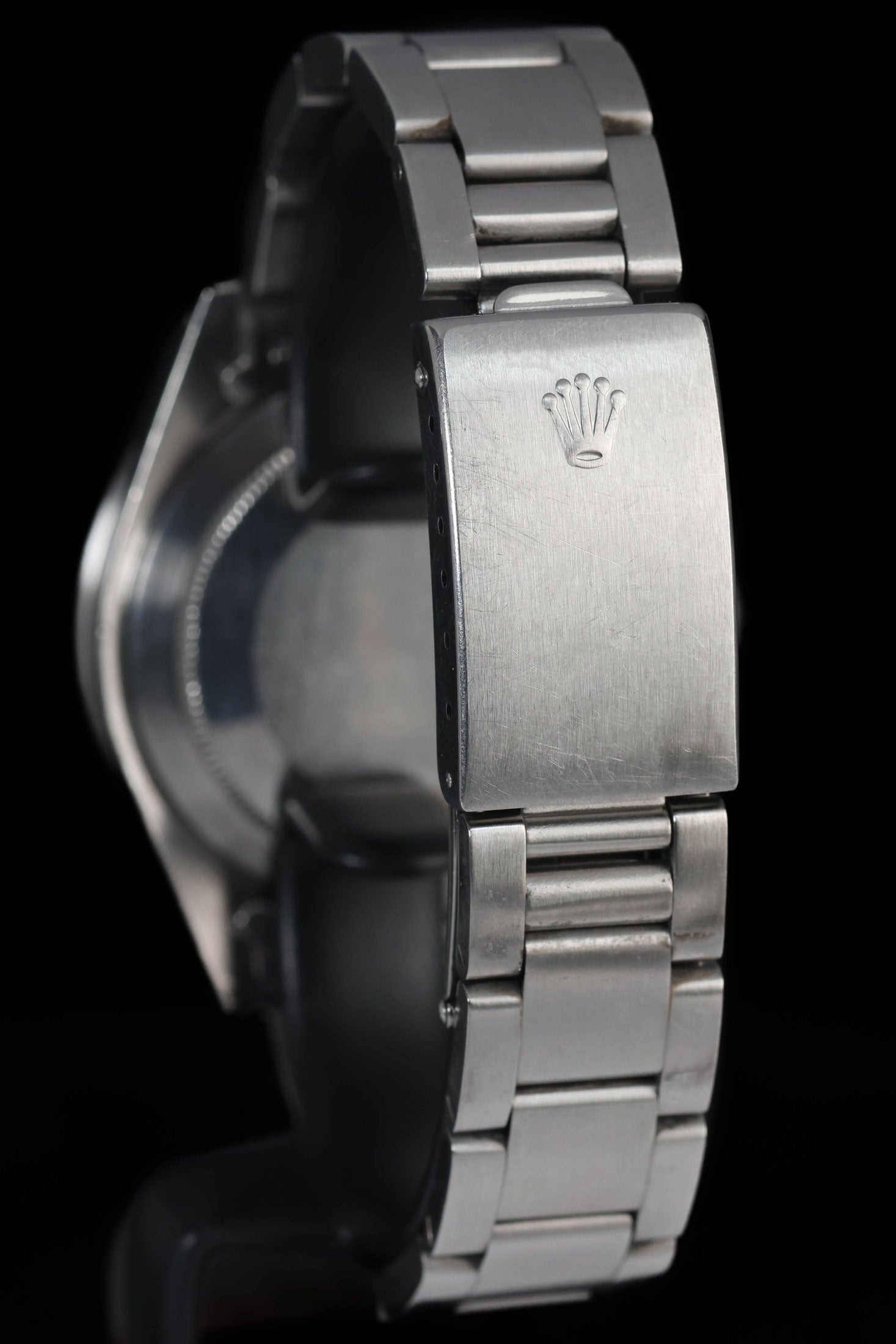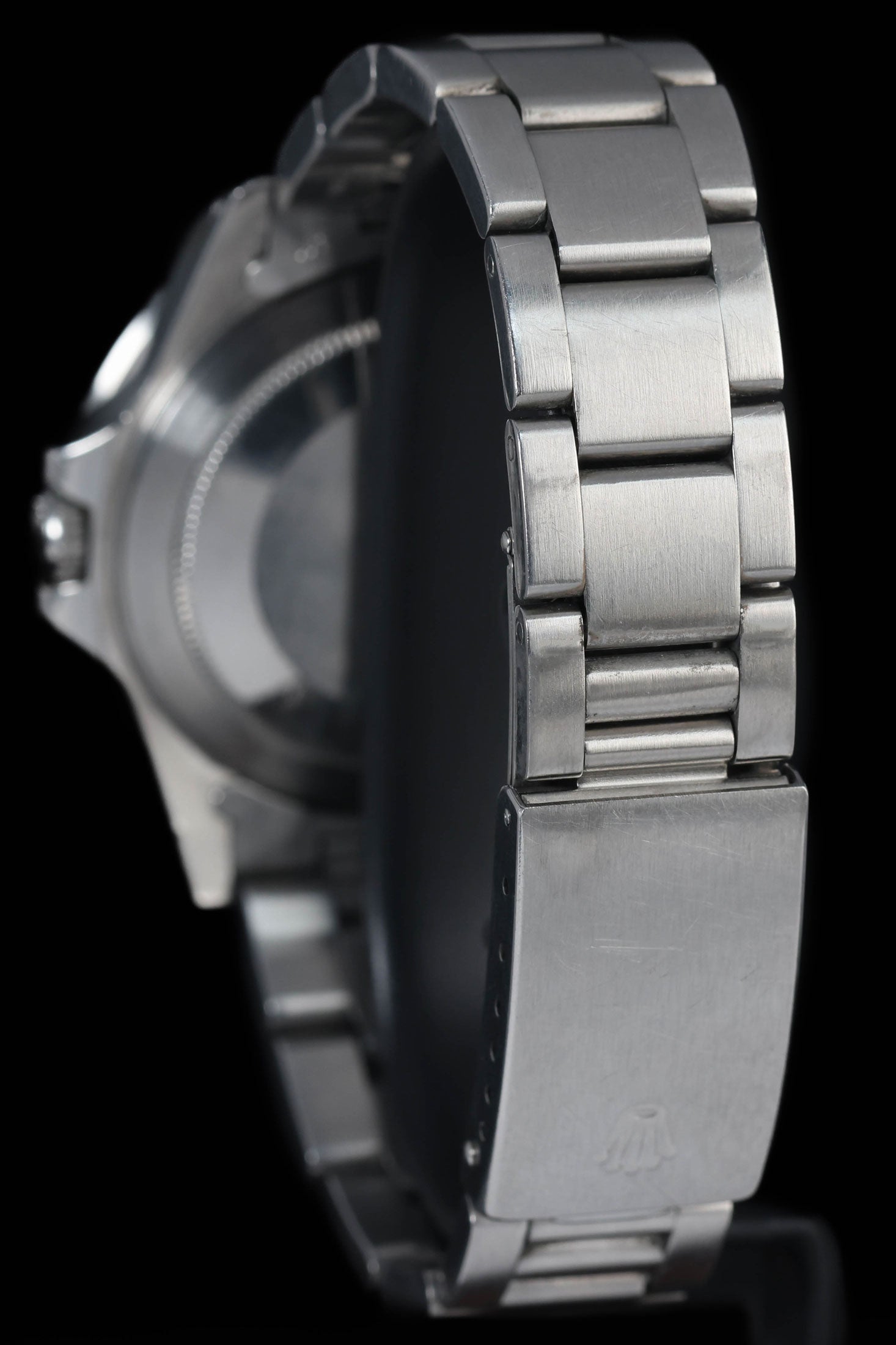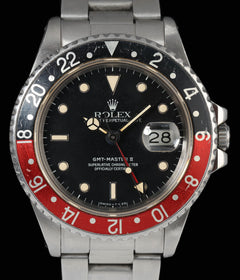Crown Vintage
Rolex GMT Master II 16760 'Fat Lady' 40MM 1986
Rolex GMT Master II 16760 'Fat Lady' 40MM 1986
Couldn't load pickup availability
Rolex GMT Master II 16760 'Fat Lady'
Case retains its original lines with fine hairline scratches throughout, matching gentle wear on the bracelet and minimal stretch. The Coke bezel and insert display several visible scratches, but numerals remain legible. Gloss black dial is starting to warm toward a tropical brown tone; tritium plots and matching hands are intact with no flaking or discolouration beyond the expected patina. Overall, a sound vintage example showing honest age-appropriate wear.
Share
Why we love this watch
Why we love this watch
Rolex GMT-Master II 16760 “Fat Lady”
Origins of the Second-Time-Zone Revolution
When the first GMT-Master arrived in 1954, it changed commercial aviation forever by letting Pan Am pilots track two zones at once. By the early 1980s, however, professional flight crews needed even more flexibility. Rolex answered in 1983 with the reference 16760—the inaugural GMT-Master II. Although the model’s run lasted barely half a decade, it introduced an independent jumping hour hand, sapphire crystal, improved water-resistance, and a bidirectional bezel with a bolder red-and-black colourway. The “Fat Lady” nickname, earned for its notably thick case and crown guards, belies how slender modern sports watches have since become; in 1983, it was a sizeable leap in robustness. The 16760 paved the way for every subsequent GMT-Master II, from the aluminium-insert 16710 right through to today’s Cerachrom-bezel references.
Case and Proportions: Why “Fat Lady”?
Rolex thickened the mid-case and crown guards to house the new calibre 3085 and its extra gear-train. At roughly 12.3 mm high—almost a full millimetre taller than the outgoing GMT-Master 16750—the watch gained a more muscular stance on the wrist. Crown guards became wider and more squared-off, while the bezel knurling grew slightly broader to give pilots better grip with gloved hands. Lug width remained 20 mm, so the watch still accepted standard Oyster and Jubilee bracelets, yet the profile felt brawnier than any previous GMT. From a distance, the extra case girth and the single available bezel colour scheme made the 16760 an easy spot compared with its slimmer siblings.
The Calibre 3085: Independent Hour Hand
Engineering the independent, quick-set local hour was the design team’s central challenge. Calibre 3085 took the architecture of the trusty calibre 3035 and added a 24-hour wheel that could be disengaged from the main time-train. Using the crown in its second pulled position, the wearer could jump the local hour forward or back in one-hour increments without stopping the seconds or disturbing the minute hand—a huge advance for trans-meridian travellers who previously had to hack the movement or rotate the bezel each time they landed. Despite the additional complexity, Rolex maintained the full set of reliability features: a Glucydur free-sprung balance, Breguet overcoil, 28,800 vph beat rate, and 48-hour power reserve. Chronometer certification remained standard, with COSC testing every finished movement before casing.
Dial, Hands and Bezel Variations
Unlike later GMT-Master II references, the 16760 stayed visually consistent throughout its production run. Dials were only offered in glossy black, initially with tritium markers printed directly on the lacquer surface, later shifting to applied white-gold surrounds filled with tritium paste. Early examples show a subtle “Swiss-T<25” signature, while later dials carry “T<25 Swiss – T<25” at six o’clock. The familiar Mercedes hour, lollipop seconds and pointed GMT hands remained, though the 24-hour pointer became a vivid red aluminium shaft culminating in a wide triangle tipped with tritium.
The bezel insert—anodised aluminium, not ceramic—debuted the now-iconic red-and-black “Coke” scheme. Red covered the daylight half, black the night hours. Font, serifs, and triangular marker at 24 remained close to the 16750’s insert, but the colour split gave pilots an instant visual cue when rotating the bezel to calculate a third time zone. Rolex never offered a red-and-blue “Pepsi” insert for the 16760, making the Coke identity inseparable from the model’s legacy.
Materials and Bracelet Options
Stainless steel 904L (though Rolex still called its alloy “Oystersteel” only in marketing much later) formed the case, case-back and bracelet. Buyers could choose between the robust three-link Oyster ref. 78360 and the dressier five-link Jubilee ref. 62510H, both tapering to 16 mm at the clasp. End links carried the number 501 or 502, depending on production year, and clasp codes track year-to-year with Rolex’s typical alphabetical system. Solid central links would not appear until decades later; 16760 bracelets relied on folded or hollow centres, keeping the overall heft down despite the thicker head. Lug holes were drilled through, making strap changes straightforward and giving modern collectors the option of fitting the watch to leather or NATO without fiddling spring bars from the inside.
Crystal, Crown and Water Resistance
One of the least-heralded upgrades was the sapphire crystal. Prior GMT-Master references used acrylic, prized for its warm glow but vulnerable to scratches. The sapphire not only repelled desk-diving scuffs; its slimmer gasket allowed Rolex to certify the 16760 to 100 metres rather than the 50 metres quoted for acrylic GMT-Masters. The crystal still carried the signature Cyclops magnifier over the date at three o’clock, bonded to the exterior surface rather than moulded as on acrylic predecessors. A Triplock crown replaced the Twinlock, identifiable by its three dots beneath the coronet. Together with a thicker case back gasket, these measures brought true tool-watch durability to the line.
Wearing Experience and Practicality
On paper, the dimensions look modest by 2025 standards: 40 mm diameter, 12.3 mm thickness, 47.5 mm lug-to-lug. Yet the “Fat Lady” feels more purposeful than early automatic GMT-Masters. The broader mid-case spreads weight evenly, and the Oyster bracelet’s flat links mitigate top-heaviness. Modern wearers accustomed to larger sports watches will find the 16760 a sweet spot—substantial but not overbearing, exactly the sort of proportion the user appreciates given their aversion to oversized pieces. Meanwhile, the independent hour hand remains the most intuitive way to track multiple zones: rotate the crown. For frequent flyers, it remains as useful in 2025 as it was in 1983.
Legacy in the GMT-Master Line
Although produced only until 1988, the 16760 laid down the blueprint. Every GMT-Master II since has featured a separately adjustable local hour, a sapphire crystal and 100 m water-resistance. The next reference, 16710, slimmed the case and introduced multiple bezel colours, but internally the calibre 3185 was an evolution, not a reinvention, of the 3085. Even the flagship ceramic models now rolling off Geneva’s assembly lines still use a jumping-hour mechanism descended directly from the “Fat Lady”. In hindsight, the 16760 marks the exact point where the GMT ceased to be merely a pilot’s aid and became Rolex’s all-purpose travel companion, equally at home on a cockpit yoke or slipping under a business-class cuff.
Cultural Footprint
While the Pepsi-insert GMT-Masters often steal the limelight in pop culture, the red-and-black 16760 enjoyed its share of screen time. It appeared on the wrist of Tom Selleck in later seasons of Magnum, P.I. and could be spotted on the arms of airline captains in Pan Am training videos during the twilight of the Boeing 747-100 era. Beyond the cockpit, musicians and Wall Street traders favoured its no-nonsense palette—black tie at night merged with red-tie power breakfasts the next morning, all without swapping watches. In the 1990s, collectors ignored it, chasing thin-case 1675s instead, but the new millennium’s interest in transitional references shone fresh light on the Fat Lady’s role as the origin of modern dual-time convenience.
Servicing and Parts Interchangeability
While we will not delve into maintenance advice, it is worth noting that calibre 3085 shares many consumables—mainsprings, balance assemblies, gear-train wheels—with the better-known calibre 3035. Rolex service centres therefore face no difficulty supporting the movement today. Bezel inserts, crowns and crystals remain available, although collectors often prefer period-correct parts to preserve originality. Because the reference used only one bezel colour and case material, authenticity checks focus chiefly on dial type, hand set and bracelet code rather than juggling multiple variations.
The 16760 in Comparison
Stacked against its immediate predecessor, the 16750, the Fat Lady feels like a generation-leap rather than a facelift. The independent hour hand renders the rotating bezel optional for routine zone changes, simplifying daily use. Sapphire crystal eliminates the anxiety of acrylic scuffs, and the thicker case adds a reassuring heft that echoes modern Rolex sports models. Next to its successor, the 16710, the Fat Lady stands out for its Coke exclusivity and unique proportions; enthusiasts sometimes say the later watch refined the design, but it arguably diluted the bold stance that made the 16760 memorable.
Collecting Themes
Collectors often divide 16760s into “early” and “late” based on dial printing. Early glossy dials with printed markers offer a stripped-back look reminiscent of the 16750, while later white-gold surrounds hint at the styling cues later mainstreamed in the 1990s. Bracelet choice also colours user experience: the Jubilee gives a dressy drape complementary to the Coke insert’s red highlight, whereas the Oyster underscores the tool-watch pedigree.
Why the Nickname Still Matters
Rolex nicknames usually arise from pop culture (the “Hulk”, the “Batman”) or celebrity association (“Paul Newman”). The “Fat Lady” is rare because it points to pure engineering necessity: Rolex could not achieve an independent hour complication inside the existing case silhouette, so it added waistline. By doing so, the brand placed function above fashion, and the result became fashionable anyway. The moniker sticks because it reflects this honest engineering signature—see a 16760 in profile and you instantly recognise the silhouette.
Final thoughts
The reference 16760 stands at a crossroads in Rolex history. It retained the airline lineage of the original GMT-Master yet introduced the mechanical architecture that defines every modern travel Rolex. Its Coke bezel remains singular, its case proportions unmistakable, and its calibre 3085 continues to tick, three time zones ready at a moment’s notice. For travellers who value utility, for historians who trace technical milestones, and for enthusiasts who appreciate purposeful design free from unnecessary embellishment, the Fat Lady still sings.
Case & Bracelet
Case & Bracelet
Case and bracelet are in overall good condition with hairline scratches consistent with a watch of this vintage. The bezel and bezel insert has visible scratches.
Dial & Hands
Dial & Hands
Dial is beginning to form tropical patina. Dial and hands are in good condition.
Warranty & Condition
Warranty & Condition
Crown Vintage Watches provides a minimum 3-month mechanical warranty on pre-owned watches, from the date of purchase.
The warranty covers mechanical defects only.
The warranty does not cover damages such as scratches, finish, crystals, glass, straps (leather, fabric or rubber damage due to wear and tear), damage resulting from wear under conditions exceeding the watch manufacturer’s water resistance limitations, and damage due to physical and or accidental abuse.
Please note, water resistance is neither tested nor guaranteed.
Shipping and insurance costs for warranty returns to us must be covered by the customer. Returns must be shipped via traceable courier. Return shipment must be pre-paid and fully insured. Collect shipping will be refused. In case of loss or damages, the customer is liable.
Our Pledge
At Crown Vintage Watches, we stand by the authenticity of every product we sell. For added peace of mind, customers are welcome to have items independently authenticated at their own expense.
Condition
Due to the nature of vintage timepieces, all watches are sold as is. We will accurately describe the current condition and working order of all watches we sell to the best of our ability.
Shipping & Refund
Shipping & Refund
